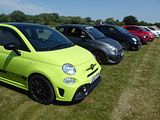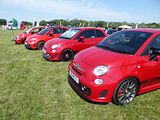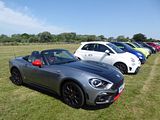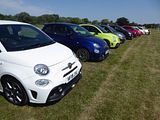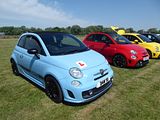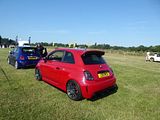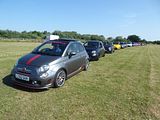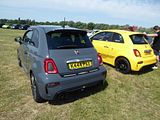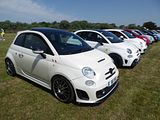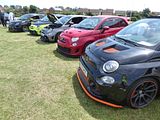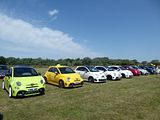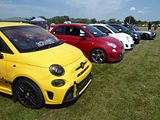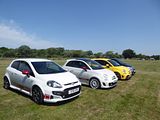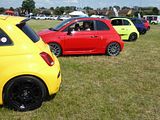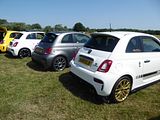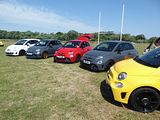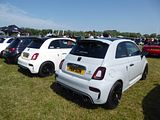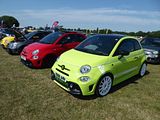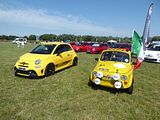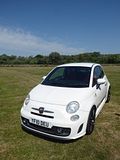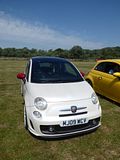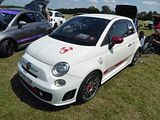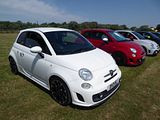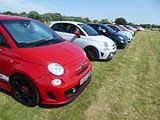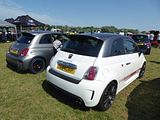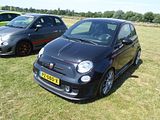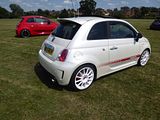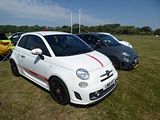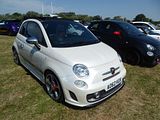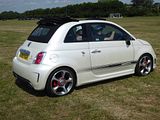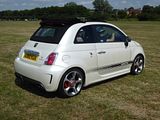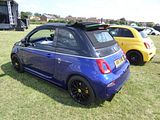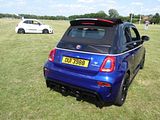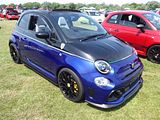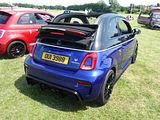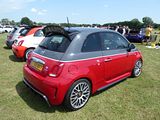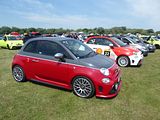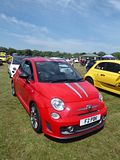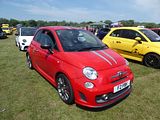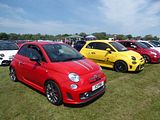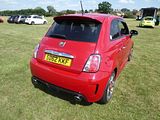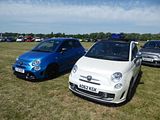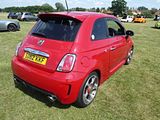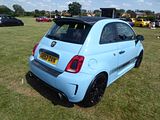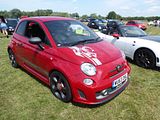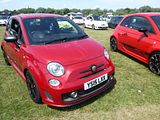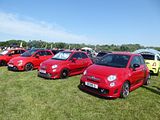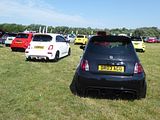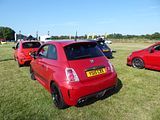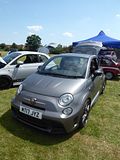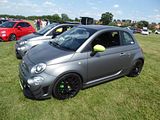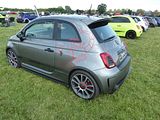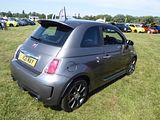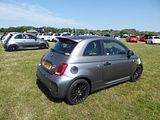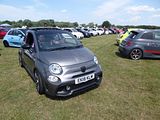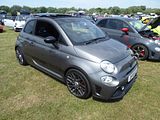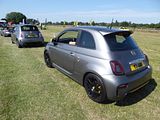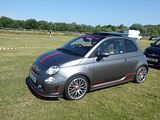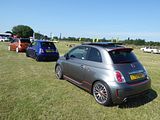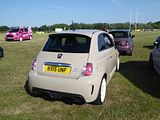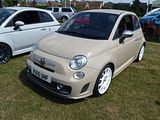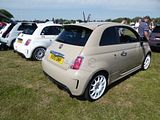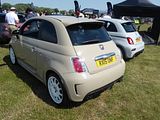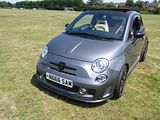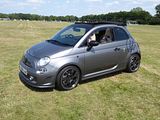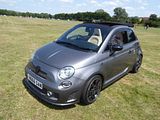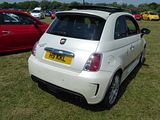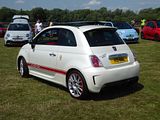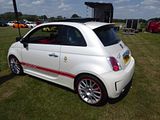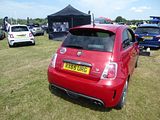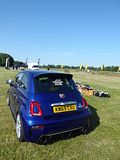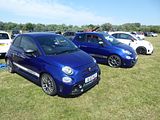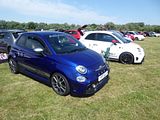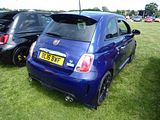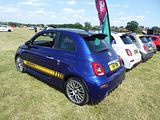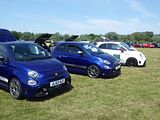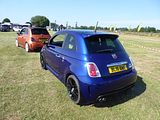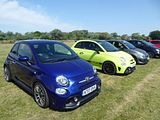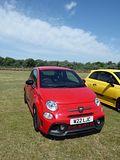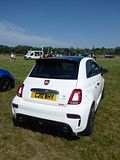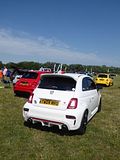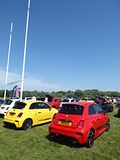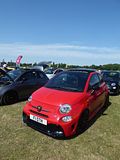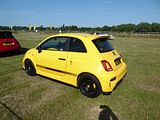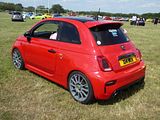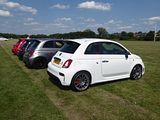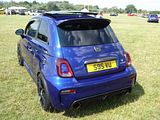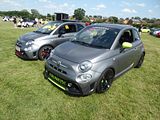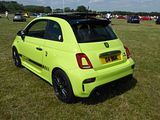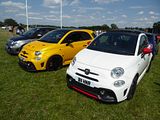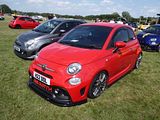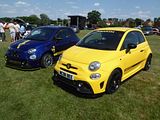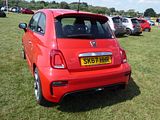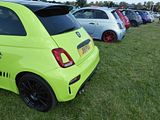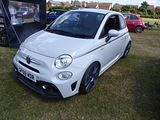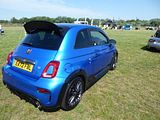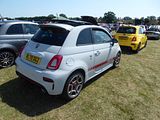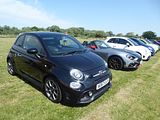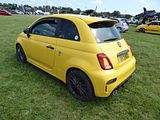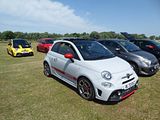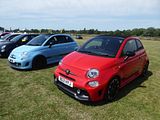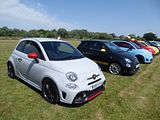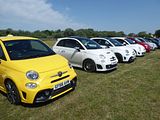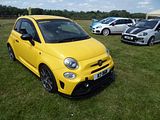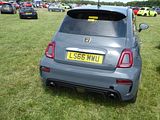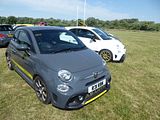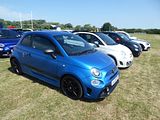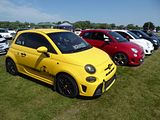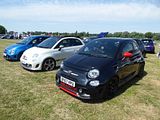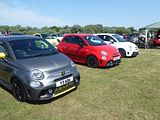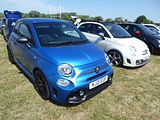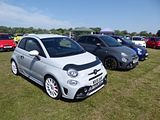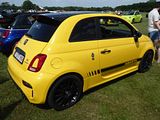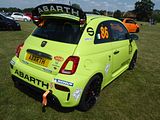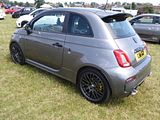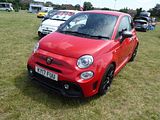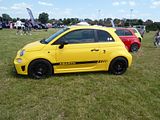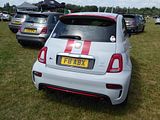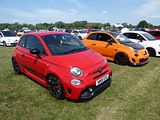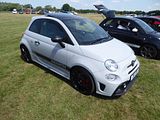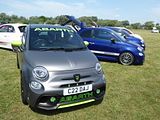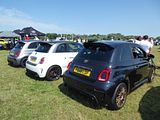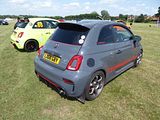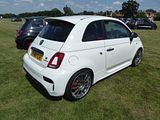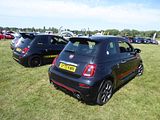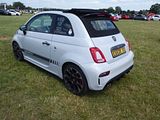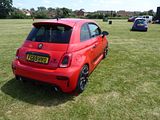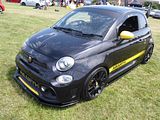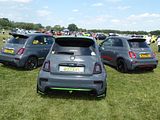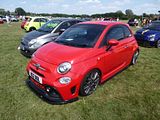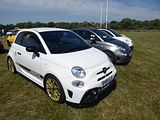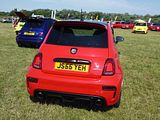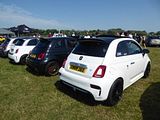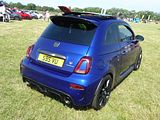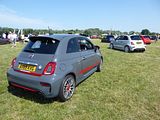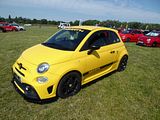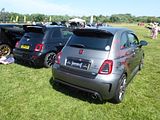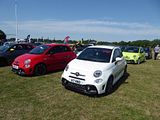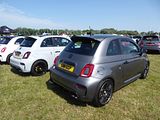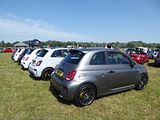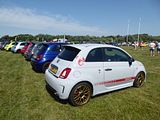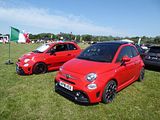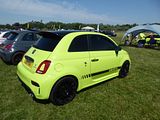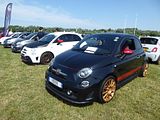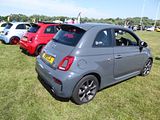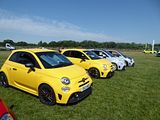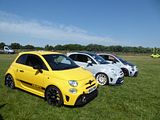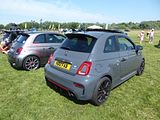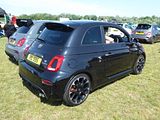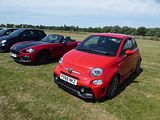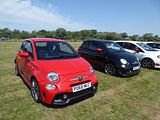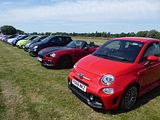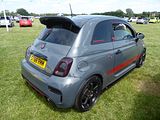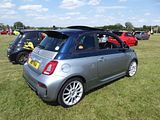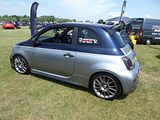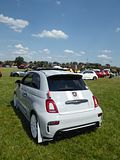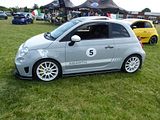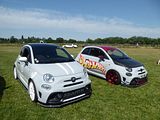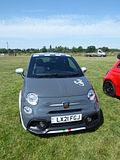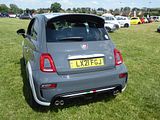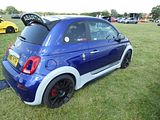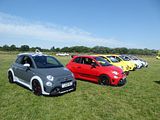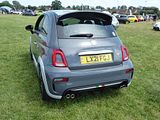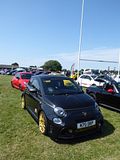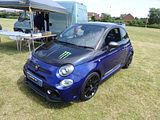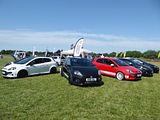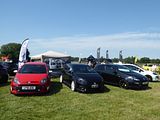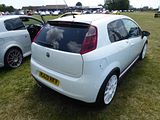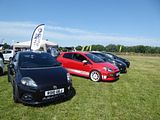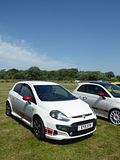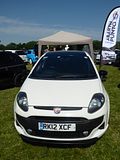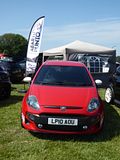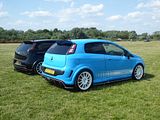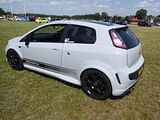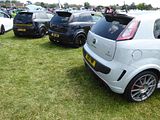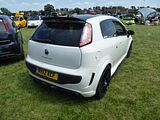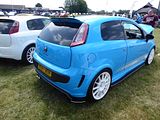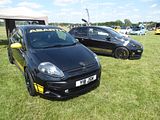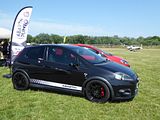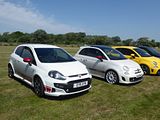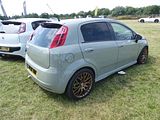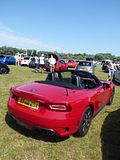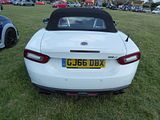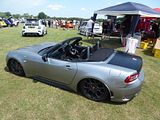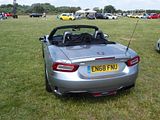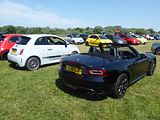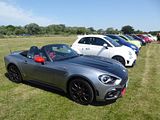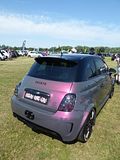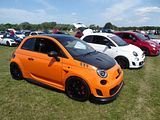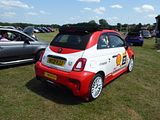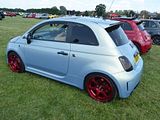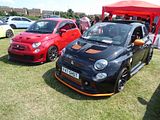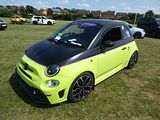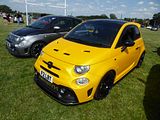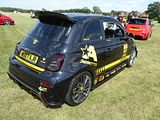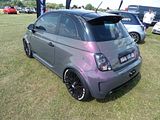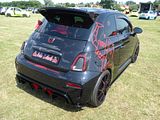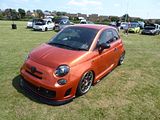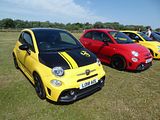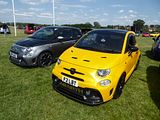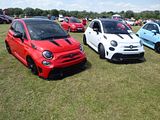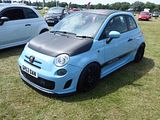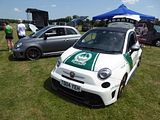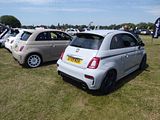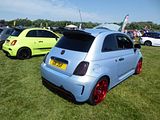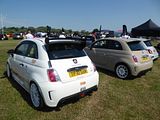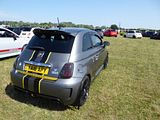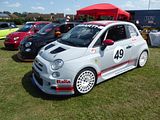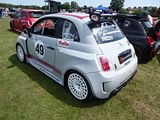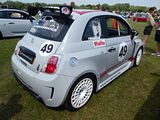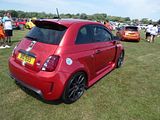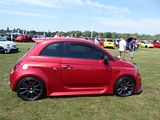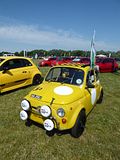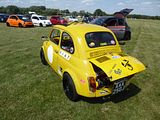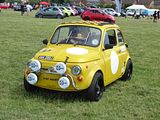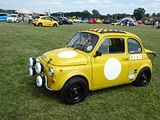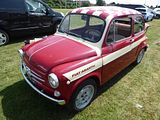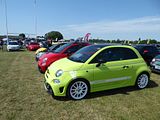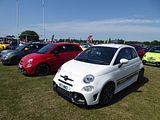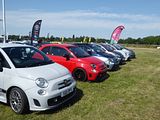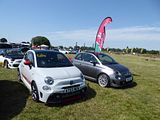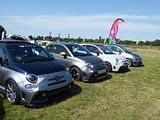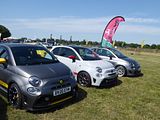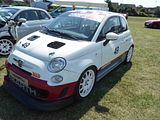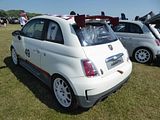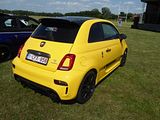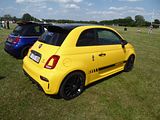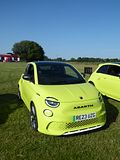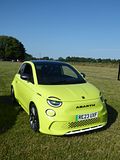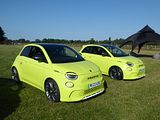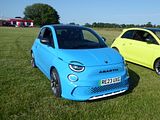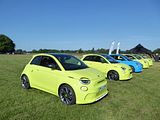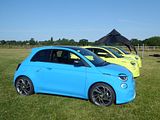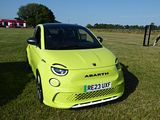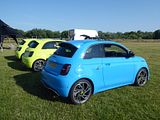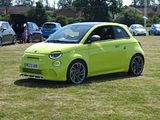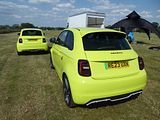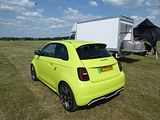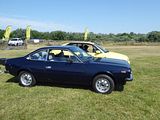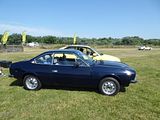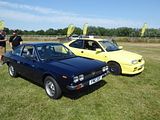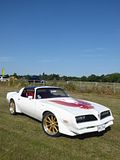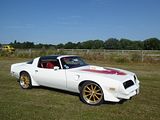Despite the fact that Abarth Festival 2021 and 2022 were hugely successful with several hundred attendees at each, the 2023 Festival very nearly did not happen. A move to a new location was forced on us, as the Finedon site that had been used for the first two events was no longer available, but our event partner, the ever ebullient Ciro Ciampi, had found St Neot’s Rugby Club as a more than acceptable alternative, offering more space, fewer potential issues in getting cars off the main road, and being centrally located in the country, as easy to get to for everyone as any national event can be. A similar format to previous years was planned, with large numbers of cars, grouped by Club, as well as a number of trade stands, a main stage and the award of prizes generously donated by event sponsors to be handed out during the afternoon. Ticket sales started early in 2023 but with a couple of months to go, they had not even reached 40 cars. Whilst it seems to be the case that more and more people are leaving attendance decisions to the last minute, we were far from confident that we were going to get anywhere close to the numbers of people who had attended in the past (over 550 cars in 2021 and 450 in 2022), so, fearful that those who did come would get a very disappointing experience, we took the reluctant decision to cancel. And then then phone rang. It was Abarth UK expressing disappointment as they had been planning to use the event as part of their launch activities for the new electric 500e. Sadly, none of them had told us before this (despite us trying to get hold of them). They even had some marketing budget. So that caused a dramatic rethink and we decided to resurrect the event and then focused really hard on trying to drive up attendance. The presence of Abarth UK and the new car seemed to the pull we needed and as the days went by, so ticket sales steadily increased and by the actual day itself we had sold around 360 tickets – down on previous years but still large enough to ensure that this would be a sizeable event and a day to remember. Even the weather played its part and this ended up being one of the hottest days of the year. Those with gazebos were very popular as they provided welcome shade from the strong summer sun, and ice cream sales were particularly buoyant all day long.
It was not long before cars started to arrive, some in convoy groups, others singly. The new location made it much easier to get cars off the road, with a long loop almost the length of the field and back again before a ticket check and the chance to hand out the goodie bags that we had been assembling as people were arriving. Once the first cars started arriving there seemed be an endless line of more to process, and for about three hours I was kept very busy, but this did mean I got the chance to exchange a few words every single attendee even if I failed to catch up with them later on. Once I could go and wander I could see some amazing groupings of cars, with just about individual model and colour that has been offered in the past 15 years.
500 FAMILY
The vast majority of cars here were the 500-based models which have been on sale now since the end of 2008, following a launch at the Paris Show that year. Since that time there have been a number of detailed changes to the standard cars and a lot of limited editions. Those who really know the marque can spot most of them, but some are so subtle that unless there is a badge you can see, you will not ne quite sure which version you are looking at. It used to be relatively easy, when the model was first launched, as there was only one version as shipped ex works called the 500. It had a 135 bhp 1.4 litre turbo-charged engine coupled to a five speed manual gearbox, with 16″ alloys as standard, and the option of 17″ wheels, and a colour palette comprising of two whites (BossaNova White, the standard colour, or the pearlescent Funk White), Red (Pasadoble), Pale Grey (Campovolo) or Black. If you wanted more power – 160 bhp – then you could order an Esseesse kit, which came in a large wooden crate, containing new wheels, springs, an ECU upgrade, the Monza exhaust system and badging. It was dealer fitted and could be applied at any time within the first 12 months or 10,000 miles from registration. Needless to say, it proved popular. As were many of the optional extras, with stickers for the sides, a large scorpion for the bonnet and even a chequered pattern for the roof among the personalisation options offered. Several of the original style of cars were here.
Whilst a sliding glass sunroof (Skydome in Fiat/Abarth parlance) was an option from inception, fans of open air motoring had to wait until Geneva 2010 for the launch of the 500C models, with a roll-back roof which provided the best of open-topped motoring and yet still with the rigidity of the regular body style.
For the first few months these cars only came with the robotised manual gearbox, which limited the appeal in the eyes of some, but they also introduced us to the “bi-colore”, a series of two tone cars, with upper and lower halves of the body painted in different colours. It took us a while to get used to this, as no other production road cars had been painted like this for some time, but now this is seen as yet another of those marque defining attributes, and (perhaps with the exception of the rarely seen Rally Beige and Officina Red combination that would come for 2014) in the eyes of many this distinctive look enhances the appeal of the cars still further.
The first of the special production models was the 695 Tributo Ferrari and there was one example of the model at the event. Most of these cars are tucked away in collections, never being used, so it was good to see this one. You got more power than was available in the standard cars at the time, with the engine uprated to 180 bhp, thanks to a different Garrett turbocharger. The spec included a MTA (Manual Transmission Automated) electromechanical transmission with paddle shifter, unique to this version 17 inch alloy wheels with performance tyres, Brembo multi-section discs with fixed 4-piston calipers, “Record Monza” variable back-pressure “dual mode” exhaust, Magneti Marelli Automotive Lighting xenon headlights, “Abarth Corsa by Sabelt” seats in black leather upholstery with carbon fibre shell and seat base, black leather steering wheel with red leather inserts and a tricolour hub, Jaeger instrument panel, non-slip aluminium foot wells, Scorpion racing pedals, special kick plates and a plate bearing the vehicle series number. The Tributo Ferrari was unveiled at the 2009 Frankfurt Motor Show, with deliveries starting in 2010. Four colours were offered: Grey, Abu Dhabi Blue, Scuderia Red and finally Yellow. Of these the red and yellow cars were more numerous, but the car remained rare as it was fearsomely expensive. Just how expensive depended on the dealer, as in a move that only the Italians could make, they were all first registered in Italy and so technically were used cars by the time these right hand drive machines arrived on UK soil, which mean that the dealers could charge what they wanted. Most aimed somewhere between £32 and £36,000, a lot for a car of this size. Nevertheless, they all sold, though many ended up on another boat, off to right hand drive Asian markets, which is why they are a rare sight these days.
Having used the legendary 695 badging from the 1960s on the Tributo cars, at the 2012 Geneva Show, Abarth dusted off the 595 name that had been used on the less powerful of the Nuova 500 based cars of the same generation, and created two new versions which we should think of as Series 2 cars, the 595 Turismo and Competizione, both of which could be bought in either closed or open top C guise, with either the 5 speed manual or robotised automated gearshifts. Both models had the 160 bhp engine as standard. Effectively they were a replacement for the Esseesse kit, and it meant that the cars were produced complete at the factory, rather than needing the dealer to undertake the upgrade (and the associated paperwork), though Abarth did not withdraw the Esseesse kits from the market for some while. Turismo, as the name suggests was aimed slightly less extreme in intent, featuring standard leather upholstery, upgraded dampers and climate control, Xenon headlights and Alutex interior details. The sportier Abarth 595 Competizione replaced the leather seats with Sabelt cloth sport seats and Alutex with aluminium, while adding p-cross-drilled brakes and the Record Monza dual-mode exhaust.
Some new colours were introduced, and very soon one of those, Record Grey, frequently combined with a tan interior became one of the most popular choices. There were several examples of this popular colour here and there is no denying that this combination suits the Abarth shape very well.
There have been many different paint colours offered during the life of the 500/595 family, some lasting only for a couple of years, others being offered for much longer than that. One of the rarest colours is called Rally Beige, and Ben Au acquired a car in this colour, because it is so rare, last year and it was one of the range of Abarths he brought along. It was the only one at the event in this paint colour.
At the 2012 Geneva Show, Abarth showed the 695C Edizione Maserati, a limited production version of the Abarth 500C convertible with the 1.4 Turbo T-Jet 16v engine rated at 180 hp, a 5-speed electrically operated manual Abarth Competizione gearbox with steering wheel controls, Maserati “Neptune” 17″ alloy wheels with performance tyres, Brembo 305 mm brake discs with fixed four-piston caliper and special shock absorbers, Record Modena variable back-pressure “dual mode” exhaust, Pontevecchio Bordeaux body colour, Xenon headlights with dipped and driving light functions, sand beige Poltrona Frau leather seats with containment strips featuring single-layer padding and the pista grey contrasting electro-welding, black leather steering wheel, aluminium pedal unit and sill plate, carbon fibre kick plate, boosted hi-fi audio system. Production was limited to 499 units, and around 20 of them came to the UK, and one of these, belonging to Neil Potter, was here. There were also some grey-painted models, initially sold in Asia but several of which are now in the UK, and Sam Cottenden owns one of these, which she brought along.
Kris Lukas brought his 50th Anniversary Edition car. This version was unveiled at the 2013 Frankfurt Motor Show, as a limited production car of which just 299 vehicles would be made commemorating the 50th anniversary of the original Fiat-Abarth 595. As that original car had been badged a Fiat, so was this one, which confused everyone who had been trying to explain how Abarth is a separate company. The UK cars listed at around £29,000 so not cheap, but for that money you got the 180 PS 1.4 T-Jet engine, Abarth Competizione gearbox, 17-inch alloy wheels with 695 Magnesio Grey design embellished and red liner, Brembo 305 mm floating brake discs, fixed four-piston caliper, special shock absorbers, ‘Record Monza’ variable back-pressure dual mode exhaust, matt three-layer white body colour, Xenon headlights with dipped and driving light functions, red leather sports seats with white inserts and red stitching, Abarth logo at black leather steering wheel with red inserts and finder and the kick plate.
Rumours started to circulate towards the end of 2014 that Abarth were going to upgrade the Competizione model, so as better to bridge the gap between the Turismo and the 190 bhp 695 Biposto that had been added to the range earlier in the year. It was Geneva 2015 when the result was finally shown to an expectant fan base. Most exciting news was that thanks to a bigger Garrett Turbo, the engine had been tweaked to 180 bhp, and with reduced CO2 emissions. A standard spec that included Koni Dampers, Brembo brakes, Xenon lights, Sabelt seats, Climate Control, parking sensors as well as other refinements that had been added like the TFT instrument display all proved very compelling, so not long after the first cars reached the UK in June of 2015, I found temptation too hard to resist, and as is well documented here, swapped my 2010 car for one of these. At the time I ordered it, Cordolo Red, a tri-coat pearlescent paint which shimmers in bright sunlight looked set to become one of the most popular colours of the lot, even though it is a cost option. Indeed, the Launch Edition models were all offered either in this colour or Scorpion Black, with black wheels. Surprisingly, the colour was not carried over to the Series 4 cars.
A new colour was announced with the new Competizione cars, called Podium Blue, but it was not going to be immediately available, and there were no accurate representations of exactly what shade it would be. Rumours circulated on Abarth forums and Facebook Groups all summer, with lots of guessing and no real facts, although we had been assured that it was not the same as the Abu Dhabi Blue that had featured on a very small number of 695 Tributo Ferrari models in 2011. It was October 2016 when the first cars reached the UK and those who had taken the gamble could see for themselves whether they had got it right. Common consent is this is a stunning colour. A rich blue, it changes shade in different lights. I think it looks fantastic. It has proved very popular and remains on offer to this day.
What is known as the Series 4 version of the familiar 595 reached the markets in the middle of 2016. After rumours had circulated all winter following the launch of the facelifted Fiat 500 last year, Abarth finally unveiled the Series 4 at the end of May 2016. Initially, we were told that the cars would not be available in the UK until September, but that came forward somewhat, with dealers all receiving demo cars in June, and the first customers taking delivery in July. Three regular production versions of both the closed car and the open-topped C were initially available, all badged 595, and called Custom, Turismo and Competizione, as before, though numerous limited edition models have since appeared and in most case disappeared. The most significant changes with the Series 4 are visual, with a couple of new colours, including the much asked for Modena Yellow and a different red, called Abarth Red, which replaces both the non-metallic Officina and – slightly surprisingly – the tri-coat pearlescent Cordolo Red. as well as styling changes front and rear. The jury is still out on these, with many, me included, remaining to be convinced. At the front, the new air intake does apparently allow around 15 – 20 % more air in and out, which will be welcome, as these cars do generate quite a lot of heat under the bonnet. Competizione models for the UK retain the old style headlights, as they have Xenon lights as standard, whereas the Custom and Turismo cars have reshaped units. At the back, there are new light clusters and a new rear bumper and diffuser. Inside, the most notable change is the replacement of the Blue & Me system with a more modern uConnect Audio set up, which brings a new colour screen to the dash. Mechanically, there is an additional 5 bhp on the Custom (now 145) and Turismo (now 165 bhp) and the option of a Limited Slip Diff for the Competizione, which is likely to prove a popular option. Details of the interior trim have changed, with a filled-in glovebox like the US market cars have always had, and electric windows switches that are like the US ones, as well as a part Alcantara trim to the steering wheel in Competizione cars. These cars have now been on offer for around six years and with Abarth sales on the rise, it was no surprise that they were particularly well represented here.
A limited edition model, the 695 XSR was created in recognition of the fact that for the third year running, in 2017 Abarth was to be the Official Sponsor and Official Car Supplier of the Yamaha Factory Racing Team, competing in the 2017 FIM MotoGP World Championship. In the wake of the Abarth 595 Yamaha Factory Racing and the 695 biposto Yamaha Factory Racing Edition, the 695 XSR Yamaha Limited Edition special series is available exclusively with a Pista Grey livery: only 695 sedans and 695 convertibles will be made. The new car was created to celebrate the Yamaha XSR900 Abarth, which is the first exclusive motorcycle to spring from the collaboration between the two brands and which sports the same grey livery with red trim as the 695 XSR, as well as sharing many of its features. The special series makes extensive use of carbon fibre to demonstrate its affinity with the front fairing, front mudguard and saddle cover of the two-wheel Yamaha. The Abarth 695 XSR and the Yamaha XSR900 Abarth also share Akrapovič ultralight exhaust developed in the racing world to boost the personality, sound and performance of both vehicles. On the Abarth car, the carbon fibre tailpipes enhance the looks and technology of the exhaust system. The XSR logo on the tailgate distinguishes the Abarth 695 XSR, while an aluminium badge identifies the sequential number of 695 units for each body type. Other carbon fibre details, in addition to the mirror caps and Akrapovič tailpipes, are available as optional equipment, such as dashboard fascia, pedal covers, gear knob and kick plate. The car uses the 1.4 T-Jet engine delivering 165 bhp. Equipment on this special series includes Koni rear suspension and Eibach springs, 17” Supersport alloy rims with Matt Black finish, Satin Chrome accents on handles and badge supports, red details on bumpers and mirrors, red brake callipers and a braking system with perforated discs. This version can be customised even further using the tuning kit to increase the power to 180 HP, improve handling by fitting a Koni front suspension with FSD (Frequency Selective Damping) valve and make braking even prompter with 305x28mm perforated and self-ventilating Brembo floating front discs with high-performance Ferodo HP 1000/1 front brake pads. It also features the new UconnectTM 7″ HD LIVE system integrated with Apple CarPlay allows iPhone users to access contents such as Apple Maps, Messages, telephone calls, Apple Music, also with Siri voice assistance.
More recently, Abarth have produced the 695 Rivale, a celebration of Fiat’s partnership with Riva, which has already seen a special Riva version of the 500,. Described as being “the most sophisticated Abarth ever”, it is available either as a hatch or a cabriolet, with both of them featuring a two-tone Riva Sera Blue and Shark Grey paintwork. The Rivale is adorned with an aquamarine double stripe, satin chrome finish on the door handles and satin chrome moulding on the tailgate, various aesthetic elements inspired by the Riva 56 Rivale yachts and ‘695 Rivale’ logos, joined by Brembo Brakes, Koni suspension, and 17-inch Supersport alloy wheels. Enhancing the nautical theme the new 695 Rivale features either a carbon fibre or mahogany dashboard, black mats with blue inserts, blue leather seats and door panels, carbon fibre kick plates, special steering wheel wrapped in blue and black leather and with a mahogany badge, blue leather instrument panel cover, and mahogany gear lever knob and kick plate. These are joined by the standard Uconnect infotainment with a 7-inch display, which is compatible with Android Auto and Apple CarPlay, and there is also a hand-written numbered plate that can be customised with the mane of the customer’s yacht on request. Powering the 695 Rivale is the same 1.4-litre turbocharged engine that makes 180PS (177hp) and 184lb/ft of torque, that features in the 595 Competizione, allowing it to go from rest to 100km/h (62mph) in 6.7 seconds and up to a top speed of 225km/h (140mph). This is a regular model in the range, but confusingly, there is also the Abarth 695 Rivale 175 Anniversary, created to celebrate 175 years of the Riva brand. Just 350 of these were produced, half of them the hatch and the other half cabriolets. These featured 17-inch alloy wheels with a special pattern, celebratory badge on the outside, hand-crafted details such as the two-tone colour – blue and black hand-stitched leather seats with a celebratory logo stitched onto the headrest, carbon dashboard silk screen printed with special logo, numbered plate. Standard Rivale cars arrived in the UK in April 2018, and quite a few have been sold. They always attract lots of interest when they do appear.
A top of the range 595 Esseesse model was added in early 2019. These cars have only sold in quite small numbers, so you don’t see them that often, but there were some here. The majority of these cars seem to be Campovolo Grey, though it was available in other colours as well. The most obvious change externally is the adoption of the neat white painted 17inch multi-spoke alloy wheels that are an Esseesse trademark, while elsewhere it gets the same recently reprofiled bumpers as the standard 595. Inside, there’s a pair of bespoke figure-hugging Sabelt high-backed seats with a carbonfibre shell and some natty red stitching, while carbonfibre trim also covers the pedals and the dashboard. Under the bonnet is the familiar 178bhp turbocharged 1.4-litre engine, but here it breathes in through a BMC filter and exhales from a switchable carbonfibre-tipped Akrapovič twin exit exhaust. There’s no more power than the old Competizione, but the Esseesse gets that model’s Brembo callipers for its 305mm front discs, plus a limited-slip differential. The suspension is largely carried over, including Koni’s frequency selective dampers. All this comes at a price though, and so this has remained a relatively rare sighting compared to the Competizione which many still feel offers rather better value for money.
The 695 Anniversario was launched at the brand’s 70th anniversary celebrations in Milan in October 2019, and deliveries of which started around the turn of the year. The Anniversario is in a choice of 5 colours: White, Black, Podium Blue, Grey and 1958 Green, and there were examples of some but not all of these here, including a couple of cars in the 1958 Green which was selected to evoke memories of the 1958 record-breaking 500, though I can advise that the two shades of green are quite different, the older car being much lighter. Online verdicts of the new car at launch were not entirely positive, with many challenging the appearance, others the spec and yet more the price (£29,995 in the UK), but in the metal, it looks far better than those first web pictures portrayed, and there is no doubt that the 1949 buyers of the car are getting something quite distinctive, with the Campovolo Grey accents around the wheelarches and lower body skirts. What they aren’t getting is more than 180 bhp, as it would seem that to get Euro 6d compliance from the T-Jet engine, 180 bhp is the limit. But the Abarth 695 70° Anniversario does have an ace up its sleeve. Look at the back and you’ll notice a rather large roof-mounted spoiler serving as the special edition’s party piece. Manually adjustable in literally a dozen of positions, the spoiler was developed in the wind tunnel to achieve maximum aero efficiency regardless of speed. Its inclination varies from 0 to 60 degrees and helps increase aerodynamic load by 42 kilograms when the car is travelling at speeds of 124 mph (200 km/h) provided the spoiler is at its maximum inclination. Abarth has done the maths and it claims the new aero component will reduce steering corrections by as much as 40% based on the testing they’ve done at FCA’s wind tunnel in the Orbassano municipality located southwest of Turin. Power is provided by the familiar 1.4-litre turbocharged engine with 180 hp and 250 Nm (184 lb-ft) of torque, good enough for a sprint from 0 to 62 mph (100 km/h) in 6.7 seconds before topping out at 140 mph (225 km/h) if the spoiler is in the 0° position. Those 17-inch SuperSport wheels are paired to a Brembo braking system with four-piston aluminium calipers finished in red, hugging the 305-mm front and 240-mm rear self-ventilated discs. Rounding off the changes on the outside is the newly developed Record Monza exhaust with active valve for a better soundtrack. Abarth also spruced up the cabin a bit where the body-hugging seats are exclusive to this special edition, just like the individually numbered plaque reminding you this isn’t an ordinary 695. Onboard tech includes support for both Apple CarPlay and Android Auto, DAB digital radio and a navigation system for that seven-inch touchscreen display. Additional standard equipment includes automatic climate control, daytime running lights, LED fog lights, unique mats, and the Abarth telemetry system if you plan on taking the hot hatch to the track.
Abarth announced two limited edition models in the autumn of 2020 and one of these was here, the 595 Scorpioneoro. Another model which takes its inspiration from a history which few in the Uk will be familiar with, there will be just 2000 units of this distinctive model available globally. The 595 Scorpioneoro was born to continue the legacy of the famous A112 Abarth “Gold Ring” of 1979, better known as the A112 Abarth “Targa Oro”, of which only 150 models produced and, as with the new Abarth 595 Scorpioneoro, what made it so special were its stylistic details. These details included black livery, gold-coloured decorative line contouring the bodywork and the alloy wheels, also painted in the distinctive gold colour. This car is liveried in the same way, marked out by its black livery, decorative gold bodywork lining and gold-painted alloy wheels. It also boasts a matt black chessboard roof and grey finish on the door handles and mirror caps. And to mirror the ‘Gold Scorpion’ name, the car is adorned with gold scorpions on the bonnet and the wheel centres. Inside the cabin of this new exciting new model, you’ll be greeted with a black dashboard which is home to the new gold finished 500 logo. Leather detailing on the seats introduces the original “scorpionflage”. The seats are further embellished with dedicated stitching and personalised headrests with the word “Scorpioneoro”, the Italian flag and Abarth embroidered on them. An additional touch of exclusivity comes from the numbered, gold coloured plaque, available solely on this model. The Scorpioneoro also comes with Abarth’s top-of-the-range seven-inch touchscreen infotainment system, complete with Apple CarPlay and Android Auto, as well as a Beats Audio sound system. Mechanically, there is nothing new, as the car has the 165 bhp version of the familiar T-Jet engine and the other features you get in the regular production Trofeo cars.
The other limited production car was the 595 Yamaha Monster Edition and Emma Woods’ car here was an example of that. One of two limited production (or Collector Edition, as Abarth have called them) cars released in September of 2020, this was the cheaper of the pair.. It was inspired by the MotoGP superbike, while the more expensive Scorpioneoro that was released at the same time was designed, so we are told. Based on the 165 bhp Turismo and like the Scorpioneoro, this limited-edition car gets new Abarth sports seats, albeit with blue finishes and the ‘Monster Energy Yamaha MotoGP’ logo on the head restraints. The blue lining contrasts with the black dashboard, while the numbered plate denoting the car’s special-edition status is placed on the central tunnel. Other features include the flat-bottomed steering wheel, sport button and the Record Monza exhaust with active valve. There’s a specially designed braking system, too, which complements the Koni rear suspension. That itself is fitted with Frequency Selective Damping (FSD) technology designed to improve the ride and handling characteristics of the car. 2000 were produced globally.
This is the Abarth 695 Tributo 131 Rally, and as you may have guessed from the name it pays homage to the fantastically-boxy Abarth 131 Rally. It was launched to mark 40 years since the 131 Rally’s last official race, and that is absolutely a car worth celebrating. In the late 1970s and early 80s, the 131 won three WRC manufacturer titles and two drivers’ championships. It looked ridiculously cool while doing so too. The 695 Tributo is perhaps slightly less cool, with no more power than the standard 178bhp 695 and the same 1.4-litre turbo engine. There’s the same Koni front and rear shocks too, plus Brembo brakes and the adjustable ‘Spoiler ad Assetto Variabile’ that was first shown on the 695 Esseesse. The Tributo 131 Rally was limited to just 695 examples though, with each one costing a fairly hefty £32,325. For that you’ll also get a Record Monza Sovrapposto exhaust, diamond-cut 17-inch alloys and three-layer Blue Rally paint. There’s also plenty of 131 Rally silhouettes to let everyone inside and out know that you’ve bought a very special version of the special Fiat 500. There was a long interval between announcement and the cars hitting the UK, and I’ve only ever seen a couple of them at events, so these look like they are going to be among the rarer of the many special editions of the 500-based car.
PUNTO
Of course, the rebirth of the modern Abarth started with the Punto, but with a relatively short production life and limited numbers produced the cars is quite a rare sighting in the UK. Around 750 of them came to the UK but some of these are no longer with us and it is believed that around 680 remain. The Punto Collective stand was given the award for Best Club Stand and deservedly so, for the imaginative way they showed off their cars, and the camaraderie among the owners.
The Abarth Grande Punto debuted at the 2007 Frankfurt IAA Show, going on sale in the UK in late summer of 2008. Offering 155 bhp from its 1.4 litre T-Jet engine, coupled to a six speed gearbox, and riding on 45 profile 17″ alloys, the standard car got rave reviews from the journalists when they first tried it, and they were even more impressed by the changes wrought by the optional Esseesse kit. This increased power to 177 bhp, brought 18″ OZ lower profile wheels, whilst new springs lowered the ride height by 15-20mm, and high-performance front brake pads and cross-drilled front disc brakes helped the car to stop more quickly. The most distinctive feature of the car were the white alloy wheels, though, as owners found, keeping these clean is not a job for the uncommitted, and many have a second set of wheels that they use for grubbier conditions. Despite the positive press at launch, the car entered a very competitive sector of the market, and the combination of being relatively unknown, a limited number of dealers and the existence of established rivals from Renault and others meant that this always remained a left-field choice. The owners loved them, though, and they still do. The oldest cars have now had their 10th birthdays, and some have amassed relatively big mileages, but they are still a car for the cognoscenti.
The Punto Evo was launched at the 2010 Geneva Show, with the cars reaching UK buyers in the summer of that year, and it incorporated many of the changes which had been seen a few months earlier on the associated Fiat models, the visual alterations being the most obvious, with the car taking on the nose of the associated Fiat, but adapted to make it distinctively Abarth, new rear lights and new badging. There was more to it than this, though, as under the bonnet, the T-Jet unit was swapped for the 1.4 litre Multi-Air, coupled to a 6 speed gearbox, which meant that the car now had 165 bhp at its disposal. Eventually, Abarth offered an Esseesse kit for these cars, though these are exceedingly rare. Part of the Punto Evo family is the SuperSport, usually identified by the distinctive black bonnet, though not all cars feature it. Just 199 of the SuperSport versions were built, of which around 120 are registered on UK roads. These cars had many of the options from the Punto Evo included as standard. Power came from the 1.4-litre MultiAir turbo engine, tuned to produce 178bhp and 199lb ft of torque, up from 165 of the standard Punto Evo, giving the SuperSport a 0-62 time of 7.5 seconds and a top speed of over 132mph. To help put the power down, the SuperSport was fitted with wider 18″ wheels and optional Koni FSD dampers. Standard equipment included the Blue&Me infotainment system with steering wheel controls, automatic climate control and a popular option was the ‘Abarth Corsa by Sabelt’ sports leather seats. The SuperSport was available in the same colours as the regular Punto Evo, which means white, grey, black and red.
In Europe, all Abarth Punto cars had three doors, but there have been five door versions offered in other markets, notably India. As far as is known, none of these cars have come to the UK, but some people have applied a lot of Abarth-ness to a UK market five door Punto and we had one such example here.
124 SPIDER
Completing the different models from the modern Abarth catalogue were a number of examples of the 124 Spider. Eagerly awaited, the 124 Spider went on sale in September 2016. A quick reminder as to what this car is: The Abarth 124 Spider was developed in parallel with the Fiat model. It does cost a lot more, and there are those who think you don’t get enough extra for your money, but those who have driven it will tell you otherwise. You certainly get more power. The 1.4 MultiAir turbo unit jumps up from 138bhp to 168bhp, while torque also increases by a modest 10Nm to 250Nm, which gives it a 0-62mph time of 6.8 seconds, which is half a second quicker than the 2.0-litre Mazda MX-5. The top speed is 143mph. It weighs just 1060kg meaning a power-to-weight ratio of 158bhp-per-tonne, and with the new Record Monza exhaust system it sounds great even at idle. The Abarth version gets a stiffer suspension setup than the regular Fiat 124 Spider, with Bilstein dampers and beefed-up anti-roll bars. Bigger Brembo brakes also feature, with aluminium calipers. It can be had with a six-speed manual or six-speed automatic transmission with paddles, and the latter gets a Sport mode for quicker shifts. Many of the UK cars sport the ‘Heritage Look’ pack, which is a no-cost option. It brings a matt black bonnet and bootlid, plus red exterior trim detailing and has proved popular. The £29,565 starting price gets you standard equipment such as cruise control, climate control, Bluetooth, a DAB radio and satnav, plus Alcantara black and red (or pure black) seat trim. The automatic gearbox is a £2,035 extra, while an optional visibility pack brings LED DRLs, auto lights and wipers and rear parking sensors. Production ceased in 2019 and around 1800 examples came to the UK, so this will always be a rare car. You might not have though so on the evidence of this event, though. As well as plenty of the standard car, there were a number of examples of the GT.
AND ALSO….
A large number of Abarth owners modify their cars, in the quest of extracting more power or simply because they want to personalise them in some way. Over the years a vast amount of knowledge, expertise and experience has been amassed and there is a very active group called Modified Abarth which is the focal point for this topic. As well as supporting the event, a number of the well known modified cars were on display here.
This is not so much modified as bespoke. It was acquired by Abarth fan Dave Quinn a while back, but took some time to get it so it could be road registered. That happened in 2021 and since then, the car has been seen at a number of UK events and it has also been driven over to Belgium. Effectively this takes its inspiration from the Assetto Corse race cars produced in 2010 and it has a Romeo Ferrari bodykit on it. Just two were created and the other one is in Italy. Not really a long distance car, Dave had to get it back to Yorkshire after the event.
Equally distinctive but in a different way is this car. To me, and those who knew it when it was new, it will always be thought of as “Bad Box, as this was the forum name of the first owner, Mario Cee. He bought it after a season where it was shown by Daron Brown of TMC MotorSport who created the car to show the art of the possible. No expense was spared in its creation, from the addition of a Romeo Ferrari bodykit and a full repaint using layer upon layer of Alfa 8C paint, which just as paint cost in excess of £4000. Mario had the car for a little while then commissioned a replacement, based on the 500C bodyshell, and that was also to be seen at shows for a while before he moved it on. This car has now had a couple more owners and has taken up residence in South Wales after a stint in the Manchester area. It proved quite a crowd puller.
This incredible little machine belongs to marque enthusiast Victor Mayer. He calls it the Ratacello, and it was only recently handed over to him, having been built from a standard 500 by Tristan Brunt of Tiny Car Company, a real specialist in these small cars.
This one is based on the slightly larger Fiat 600. The Fiat-Abarth 850TC Berlina (Turismo Competizione, or “touring competition”) was introduced towards the end of 1960. Originally built to Group 2 touring car specifications, it was manufactured between 1961 and 1969. It uses the Fiat 600 bodywork with some modifications, most notably a boxlike structure ahead of the front bumper which held the engine’s oil cooler. The rear fenders were usually blistered, so as to accommodate larger wheels. The engine is a four-cylinder model based on a Fiat unit, with 847 cc capacity and 52 PS (51 bhp) CUNA rating. Overall length is 3,090 mm (122 in), overall width is 1,400 mm (55 in), height is 1,380 mm (54 in), wheelbase is 2,000 mm (80 in), and its front and rear track are 1,160 mm (46 in). The fuel tank holds 5.9 imperial gallons. The 850TC remained in the price lists until 1966. In 1962 the 850TC Nürburgring was introduced, with 55 PS at 6500 rpm. The name was intended to celebrate the class victory of an Abarth 850TC at the 1961 Nürburgring 500 km race.[20] There followed the 850TC/SS with two more horsepower; this was renamed the 850TC Nürburgring Corsa towards the end of the year. Between 1962 and 1971 the 850cc and 1,000cc class cars won hundreds of races all over the World and were commonly called “Giant Killers” due to their superior performance over much larger cars. This culminated in a famous dispute with SCCA authorities in the USA when Alfred Cosentino (FAZA) was banned from running his 1970 Fiat Abarth Berlina Corsa 1000 TCR “Radiale” engine because his car was faster (mainly in wet conditions) than many of its V8-powered contemporaries. The SCCA authorities dictated FAZA and Cosentino be forced to use an earlier, non-Radiale, engine design from the 1962 model in their cars. They still achieved 51 victories from 53 races, the most victories in SCCA racing history, thereby cementing the superiority of the Fiat Abarth Berlina Corsa over larger and more powerful cars.
CLUBS
There are in excess of 25 different Clubs within the UK Abarth Community, most of them with a geographic focus, catering for people in a defined area of the country with a range of more local meets, and almost all of them were here and each had their own dedicated parking area. A prize of £500 was awarded to the Club with the biggest presence, and once again, as had been the case in 2022, that ware went to Abarth Essex.
OTHER AWARDS
A number of the event sponsors had generously provided prizes and in the interest of fairness, they were each invited to select winners from all the cars present. Sam Cottenden, with her 695C Edizione Maserati won the prize for Best Paint, while Best Modified went to a highly converted Fiat 500-based white car that had been done on a budget. Other awards were handed out to Ed Tan with his “Blue badge” bi-colore 595C Competizione and the Dubai police liveried car of Damian Morley, the Show & Shine went to Jon Petts with a beautifully presented 124 Spider and the overall Car of the Show went to a proud Les Bell whose white car not only looks distinctive but has over 350 bhp.
Furthest Travelled was awarded to Brecht Venken from Belgium who had come over specially for the event.
AND SO TO THE FUTURE
The Abarth New 500e Scorpionissima is a performance variant that made its official debut on 22 November 2022, featuring unique scorpion-badged alloy wheels. Initially, it is being released in a Scorpionissima edition limited to 1,949 examples. Scorpionissima models will be available in a choice of Acid Green or Poison Blue colours, bearing unique side graphics and wheels. The first deliveries were scheduled for June 2023. It has a single electric traction motor that produces 114 kW (153 hp) and 235 Nm (173 lb/ft), an increase of 26.7 kW (35.8 hp) and 15 Nm (11 lb/ft) over the standard motor, and accelerates from 0 to 100 km/h (62 mph) in 7 seconds. The enhancements in power and torque output are derived from improved inverter and battery wiring, and a reduction in the final-drive ratio. The Abarth also swaps the rear drum brakes on the New 500 for discs. Three driving modes are offered: Turismo, Scorpion Street, and Scorpion Track; output power and torque are limited to 100 kW (130 hp) and 220 Nm (160 lb/ft) in Turismo. Scorpion Street maximizes regenerative braking, simulating the engine braking effect of a conventional car equipped with a manual transmission, while Scorpion Track sacrifices range for performance. In manufacturer testing at Balocco, the Abarth 500e is able to complete laps 1 second quicker than the Abarth 695. Total weight is 1,410 kg (3,110 lb), including the 295 kg (650 lb) battery. Charging hardware is carried over from the regular New 500 equipped with the larger battery, at rates up to 85 kW. The Abarth 500e has a battery with a capacity of 42.2 kWh (gross) and 37.3 kWh (net), giving the vehicle a claimed range of 264 km (164 mi) under the WLTP driving cycle with the standard 17-inch wheels; equipping the 18-inch wheels reduces range to 253 km (157 mi). Real-world mixed driving with 18-inch wheels indicated an actual range of 212 km (132 mi), with consumption of 3.4 mi/kWh.
This event marked the UK premier of the 500e, even before the press get the hands on the cars, which will happen a few days after those present had seen it. Abarth UK brought along 5 cars, and had three of them out on the road virtually all day with a short test route into St Neots and then out on the A1, which lasted about 15 minutes. After watching the cars come and go all day long, I got my chance late in the day when most people had gone home, and was accompanied by Pietro, the Brand Manager for the new Electric cars, so got the chance to have a good chat with him as well as to experience the car form behind the wheel. It was only a short test route, but I have to say that I liked the car a lot more than I thought I would. The new interior is a massive improvement on the current cars, of course, but what also impressed was how the car drove, and I even liked the synthesised sound, which I had thought might come across as a bit of a gimmick, but which really is not. I think most people who got to the drive the cars were equally impressed and pleasantly surprised. Will the car sell and will we have rows of these at Abarth Festival 2024? Time will tell.
SPECTATOR CARS
When the event was first launched, and somewhat of a surprise to the Abarth Owners Club team, Ciro announced that there would also be an associated Italian Car Show. His rationale was that there was plenty of space and getting extra cars would help to fill it. We did point out that the event needed to feel like it was an Abarth event, and this feedback came very strongly indeed from the members, so when the event was relaunched, no mention was made of the other Italian cars idea, but even so, a couple of turned up, along with an American interloper.
The Beta family formed the core of Lancia’s range throughout the 1970s, The Berlina model came first, launched at the 1972 Turin Show. In its day, it sold in greater numbers than cars like the rival BMW, though few would believe that now. In 1973 the second style to appear was a 2+2 two-door coupé with a 93″ wheelbase, although due to the fuel crisis it did not become available to the public until early 1974. It was launched with 1.6 and 1.8 engines. New 1.6 and 2.0 engines replaced the original units in late 1975 followed by a 1.3 in early 1976, at which point the Fulvia Coupe was deleted. In 1978 automatic transmission and power steering became available. In 1981 the car received a minor facelift and at the same time the 2.0 became available with fuel Bosch electronic fuel injection. In 1983 a 2.0 VX supercharged engine became available with an output of 135 bhp. The bodywork was developed in-house by a Lancia team led by Aldo Castagno, with Pietro Castagnero acting as styling consultant. Castagnero had also styled the Beta’s predecessor, the Lancia Fulvia saloon and coupé. The car was popular in the mid 1970s with 111,801 examples being built, though they are quite rare now.
Parked behind it is an example of the second generation Delta – a car that was never sold new in the UK, but a few examples of which have come here since the mid 90s when it was a current vehicle.
The 1977 Firebird received a facelift that featured four rectangular headlamps. The shaker scoop was also revised for this year, with the early 1977-built T/As coming with off-center, lower-profile shaker scoops. The Formula hood was changed for the last time for the second generation with a much lower profile. The snowflake wheel became an option for all Firebirds and was standard with the Y82 appearance package, although it could be replaced with Rally II wheels as a credit option. For the Esprit, an optional appearance package RPO W60 called the “Skybird appearance package” became available, featuring an all blue exterior and interior. This package was originally slated to be called the “Bluebird” similar to the “Yellowbird” and “Redbird” packages to follow in the upcoming model years, but the name was already in use for a company that produced school buses. In 1977, General Motors began to source a larger selection of V8 engines to supply in the lower model Firebirds, and the Oldsmobile 350 V8, as well as the Chevrolet 350 V8, became options for the Firebird, Esprit, and Formula. Previously, the Chevrolet inline-six was the only outsourced engine in a Firebird. Pontiac made the 301 (4.9 L) V8 available for order in the lower Firebird models, but due to such high demand and popularity, they removed it’s availability from the Firebird model to allow enough 301 engines for the other Pontiac lines. It was re-introduced as an option in 1979 as production for the 400 ceased and tooling was converted over to the 301. The Trans Am had now three different engine options, the standard Pontiac L78 400, the optional extra cost Pontiac W72 400, and the Oldsmobile-sourced L80 403. 1977 also saw the cubic inch metrics on the shaker dropped in favour of the displacement of the cylinders. The shakers had a “6.6 Litre” decal for all L78 Pontiac 400 and L80 Oldsmobile 403 engines. Only the optional W72 Pontiac 400 received the “T/A 6.6” decal. As Pontiac had discontinued the 455 in the previous model year, a modified 400 Pontiac V8 dubbed the “T/A 6.6” RPO W72 with a single four-barrel 800CFM Rochester Quadrajet carburettor rated at 200 bhp at 3,600 rpm and a maximum torque of 325 lb/ft (441 Nm) at 2,400 rpm, as opposed to the regular “6.6 Litre” 400 (RPO L78) rated at 180 bhp. The T/A 6.6 equipped engines had chrome valve covers, while the base 400 engines had painted valve covers. For 1977, the W72 shared the same air cleaner and shared the same 500577 cast block as the L78, but received the 6×4 heads, whereas the L78 only received the 6×8 heads. The 6×4 heads were used on early Pontiac 350 blocks that helped increase the compression, and also had hardened valve seats for a higher RPM operating range. The Oldsmobile 403 was implemented as the 400 Pontiac could not satisfy emissions requirements for high-altitude states and California. Wanting to still offer a 6.6 litre option for the Trans Am, the 403 Olds was seen as a suitable replacement as when equipped with an A.I.R emissions system, it could satisfy the emissions criteria for these states and still offer the power the Trans Am was known for. The L80 Oldsmobile had slightly more power than the standard L78 Pontiac 400 at 185 hp and offered the same low-end torque of 320 lb/ft (430 Nm) at a more useable operating range of 2,200rpm. From 1977 to 1981, the Firebird used four square headlamps, while the Camaro continued to retain the two round headlights that had been shared by both second-generation designs. The 1977 Trans-Am special edition became famous after being featured in Smokey and the Bandit. The 1980 turbo model was used for Smokey and the Bandit II. Changes for 1978 were slight, with a switch from a honeycomb to a crosshatch pattern grille being the most notable change to the body style. The decals for the standard Trans Ams changed from the “looping style” lettering to the “block-style” font that would remain on the Firebird until the end of the second generation. T-tops in 1978 transitioned from Hurst units to Fisher (GM) in mid-year. Pontiac also introduced the Red Bird package on the Firebird Esprit model. Painted in Roman red with a matching deluxe red interior, it demonstrated gold accents with a unique Red Bird graphic on the b-pillars. It also included a Formula steering wheel with gold spokes and gold dash bezel, similar to the ones included in the Special Edition package, however, the red and gold steering wheel was exclusive to the Red Bird Esprit. The W72 engine option also saw a revision to the camshaft duration and the tuning of the Rochester Quadrajet which lead to a 10% increase of horsepower from the following year, bringing the total to 220 hp. Additionally, the earlier stronger and more durable 481988 cast block returned on the W72, denoted with a large “XX” cast protruding off the side of the block near the cast code. The WS6 special performance package developed by Herb Adams was introduced as a handling option for the Trans Am, including a larger diameter rear sway bar, tighter ratio steering box, 15×8-inch snowflake wheels, additional frame bracing, as well as other suspension changes. Delays in manufacturing prevented the rear disc brake (RPO J65) from being available on the 1978 model year. Approximately 23.1% (28,239) of Formulas and Trans Ams in 1978 had the WS6 option according to Pontiac sales information at the start of 1979. At the end of 1978, the WS6 handling package became available for the Formula models as well. The car would continue to evolve with detailed changes for a further three model years before being replaced by a completely new design for 1982.
And so, with almost everyone departed, the organisers were able to pack everything up and reflect on the day. Considering that six weeks earlier, there was no Abarth Festival going to happen, to have pulled this event off was an amazing achievement, even if there were a few things that did not quite to plan. Most people who attended went home very happy, but we have listened to all the feedback and have realised that we probably need to do something significantly different in 2024 if we are to see an increase in the number of people attending. Watch this space!


